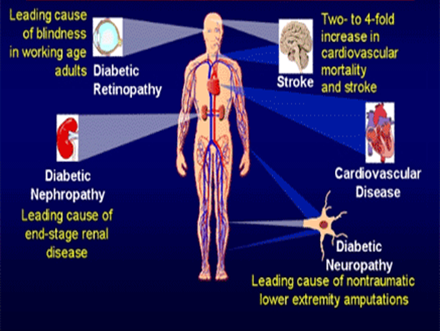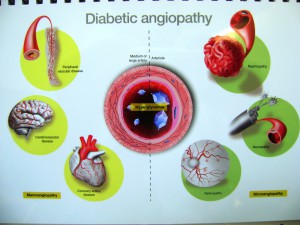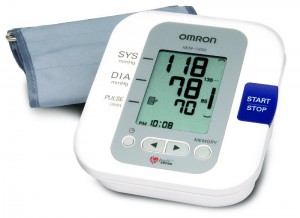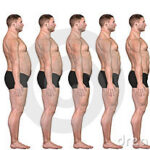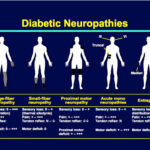Did you know that every ten seconds a person dies from diabetes related complications?
Diabetes is the fourth leading cause of global death by any disease.
The heart

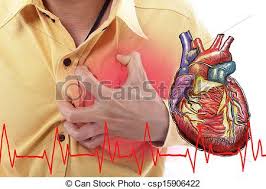
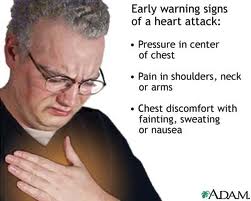
Remember that heart problem is the number one cause of death among those with diabetes. It is said that a person does not die of diabetes, but instead of the heart ailment. The presentation can be just as a spasm of the blood vessels supplying the heart muscles or a frank attack where the blood vessel supplying the heart muscle is blocked completely or the heart may be enlarged.
The pain normally associated with heart attack is absent for those with diabetes. Hence, any “simple” chest discomfort may warrant a heart check up rather than treat it as simple gastritis or “gas”. Sometimes the discomfort may travel down the left arm, neck, back or to the shoulder. If the discomfort is associated sweating and faintness, consult with your doctor immediately. There are many tests that the cardiologist( doctor who specializes in heart diseases) will order for.
Control of the blood pressure and lipids are more important to prevent a heart attack. Sugar control is not all that important to prevent an attack, though. There are medicines which may have to be started by the health care professional to prevent such a calamity.
An ECG ( electrocardiogram) is done with patient in resting state and can tell if an ongoing chest pain is related to the heart or not or if a previous episode of chest discomfort was from the heart. It also tells about the rate.
An ECHO cardiogram is also done either in resting or under some form of exercise. This shows the size of the chambers of the heart, the dimensions of the valves, the blood flow and other parameters.
A Treadmill test will show how the heart copes with exercise. Patients with problems in their back bones or knees cannot do this test unless under supervision. Changes in the heart rate, rhythm , blood pressure may be noted which can point towards a block in the coronary vessels.
A coronary angiogram is a test done to map the coronary vessels. This is done by either introducing a tube through a vessel in the thigh or through a normal cannula in the arm. A dye is injected and films are shot. Blocks can be seen which are interpreted by either the radiologist or cardiologist. The blocks can be stented or ballooned or operated depending on the site and number of blocks.
The kidney
The doctor will check the kidney function periodically to check if there is the beginning of kidney disease. Reduction of urine output and swelling of the face, body and feet with losing consciousness is a late feature. The presence of microalbumin in urine is an early feature which needs treatment. However, having menstrual periods, a mild urinary infection, having exercised just prior to giving the sample or having fever, the levels of microalbumin can be high. The health care provider will determine if another test is to be repeated. With proper control of sugar, blood pressure the levels improve. Some need medications to help reduce the levels.
Sometimes , dialysis or transplantation is needed when the kidneys reach a terminal stage. Consult with your doctor regarding the diet to be followed if there is such an event. You may have to consult a nephrologist( specialist in kidney diseases).
Eyes.
This is probably the most important of all the organs as far as we all are concerned. What is the use in living, if your eyes are not working or you are blind? Diabetes is the commonest cause of preventable blindness. One would never enjoy the beauty around us and the marvels of the Almighty if it were not for the eyes. Strangely even with good eyesight, we sometimes do “not see” the marvels of God.
Most of the people decide to meet the eye doctor when their eye sight is quite bad…. Till then most meet with the optician who checks the power of the glasses and they are happy.
Good control of sugar can prevent the onset of eye disorders. High blood pressure can also damage the eyes. Being a smoker too can affect the eye sight. It is generally believed that eye sight will become poor with advancing age due to onset of cataract (clouding up of the lens) , Being a diabetic can even make a young patient susceptible to development of cataracts.
The ophthalmologist( the doctor who specializes in eye diseases) will check the pressure in the eyes, look for cataract and also for the retina after instilling drops in the eyes. The eyes will be out of focus for close to an hour or two after the test. Remember checking the power of the eyes is not the test for diabetes check up. Close to 70% of the retina will be damaged before problems arise in vision. It is important to prevent these complications from arising by having an annual checkup with your eye doctor.
Changes in sugar levels can affect the clear fluid in which the lens is bathed in the eye. Thus there is a blurred vision which many people compare to a curtain kept in front of their eyes. The clear fluid becomes turbid when high sugar levels occur and then clears up when the sugar level normalizes. It is, therefore, important to mention to the eye specialist you are diabetic and whether under good control or not. It is wise to have new reading glasses when the sugar levels are normal.
When to meet the eye doctor?
• Blurred vision
• Trouble reading
• Seeing double
• Injury to eye
• Spots or floaters in the eyes
• Eyes get red and itchy
• You cannot see things on the outside of your eye vision field.
Know your eyes
The eyes are your mirror to the outside world. The eyes are covered by eye lids protecting it from external trauma or injury. This also prevents the eyes from drying out. Light enters through the cornea and travels through the center of the iris, which is the colored part of the eye. Light then falls on the retina situated at the back of the eye which then converts these signals to signals which can be read by the brain and is transmitted through nerves to the brain for us to understand what we are seeing. All this happens in fractions of seconds …
Know some terms
Glaucoma: This is term used when the pressure in the eyes increase. This can happen in those with a longer duration of diabetes. The vision of the eye is gradually lost. The eye doctor will perform tests which will determine how severe it is and will prescribe either eye drops or surgery.
Cataract: This is term used when the lens becomes cloudy. Normally elderly people get cataracts even without being a diabetic. Cataract may occur in younger adults if they are diabetic. The eye doctor will advise what to do after checking for cataract. For some people the retinopathy will become worse if treated for cataract and for some glaucoma may develop.
Retinopathy– this is term used to mean damage to the retina, the nerve layer of the eye. About 70 percent of the retina has to be damaged for one to show changes in eye sight. By this time, it will be so severe, complex treatment plans will have to be made with outcomes resulting in compromised vision. The small blood vessels in the back of the eye balloon out and may form pouches. They may start leaking. This may cause swelling of the nearby parts of the eye and even cause a lifting up of this layer, called retinal detachment. The eye doctor will advise how to get treated depending on the stage the eyes are.
The feet
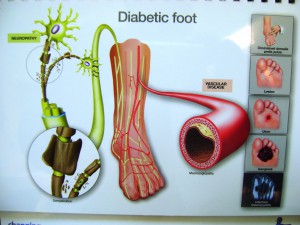 Often, this is the most neglected of all the body parts. It has been studied that women care more for their feet than men. It has also been shown in studies that the foot problems are less among the muslim population due to the washing of their feet for prayer 5 times a day. One should pamper the feet at night daily.
Often, this is the most neglected of all the body parts. It has been studied that women care more for their feet than men. It has also been shown in studies that the foot problems are less among the muslim population due to the washing of their feet for prayer 5 times a day. One should pamper the feet at night daily.
The feet may swell up ( due to high blood pressure, kidney disease, the effects of the medicines you are given, or heart disease). You may notice the skin becomes dry (which can cause itchiness), the nails can get deformed, you may notice white rashes between the toes, decreased sensation to hot and cold and small wounds go unnoticed unless pointed out by somebody.
You have to inspect your feet daily with a mirror, apply moisturizing cream to the top and bottom of the feet ( avoid the areas between the toes), trim the toe nails straight ( taking care not to cut the corners), use one size extra shows or footwear, avoid narrow footwear, use loose cotton stockings, check the inside of the shoes daily and wash your feet daily, but dry them properly. Never cut calluses( thickened skin) yourself as it will risk injury.
The doctor will usually check the pulsations of the feet blood vessels, check for temperature sensation, check for fine sensation with a thread and the reflex at the ankle. You may need to have custom made footwear in some cases.
Remember to show the doctor for any wounds or cracks or ulcers that may develop. Remember that any infection can spread rapidly in diabetic patients which may sometimes need an operation resulting in loss of limb. Coupled with smoking, diabetes is dangerous combination.
Sometimes the legs may ache while walking or may have cramps at night. This can be the starting feature of a nerve problem. Consult your doctor if this happens.
Skin:
Get educated. One key to preventing diabetic skin problems is to understand what causes them. Talk to your doctor. Learn about diabetic skin complications, what your particular risks are, and how you can lower them.
Control your diabetes. Controlling the blood glucose within normal range can go far toward preventing common diabetic skin complications.
To get a handle on your diabetes, strive for a healthy weight, eat right, cut back on salt, maintain a healthy blood pressure, and exercise. That’s a tall order, but talk to your health care team for support.
Be aware. If you suffer from diabetic nerve damage (neuropathy), you can have an infected cut, scratch, or skin puncture and not know it. Don’t let a small problem turn into a big one .Check your feet, ankles, in between your toes and legs regularly for wounds that aren’t healing.
Do something about wounds and sores. Don’t neglect wound care. If you find a nick, a scratch, a small cut, anything that isn’t healing or that worries you, talk to your doctor immediately.
Cover up. This simple first line of defense can help you avoid the cuts and scratches that can lead to infection. Whether you’re gardening or walking the dog, cover your legs with long pants and your feet with flat, good-fitting shoes.
Practice good skin care. Keeping skin clean and dry, but not too dry, is key to good diabetic skin care.
Keep skin comfortably dry, especially at armpits, toes, and groin. Talcum powder can help.
But avoid drying skin out. Skin that’s too dry can crack, itch, and get infected, so prevent that by taking short, lukewarm showers or baths and using mild soaps and shampoos when you wash. Avoid deodorant or scented cleansers, which can be harsh on sensitive skin.
Moisturize if your skin is dry . The best time to moisturize is right after a shower or bath, when skin is still moist.
Dry well by patting gently — don’t rub — focusing on underarms, between legs, under breasts, and between toes.
Diabetes and teeth
This is probably the most neglected of the various aspects of ones body. Many are unaware that care of the mouth is as important as looking after the eyes, feet or heart when one has diabetes.
Some presentations will be :
• Slow healing time after dental procedures
• Fungal infections coming very frequently( white patches)
• Dry mouth
• Cavities in the teeth
What can be done to minimize the risk
• Brush your teeth after every meal and floss the space between the teeth at least once daily.
• Use oral antibacterial rinses to wash away the germs
• Meet the dentist at least yearly once.
The gums ( pink tissue on which the teeth are embedded) can become soft, spongy and start bleeding. Later on the gums may detach themselves from the teeth causing them to have pockets. These pockets can harbor organisms which can erode into the underlying bone and can cause the tooth to be loose. The infection may spread at an alarming rate that you may have to be hospitalized and the infection can even spread to as far as the brain through the rich network of blood vessels on the face.
High Blood Pressure ( Hypertension)
Blood pressure has 2 values- a systolic ( the reading at top) and a diastolic ( reading at the bottom). This is checked at every visit to the doctor by a machine called sphygmomanometer. The most accurate one is the one using mercury( which are rare these days). Often, digital and air driven machines are used and freely available for use at home or office. Normally the blood pressure can be high when consulting with the doctor( due to anxiety). If found high, recheck either at home first thing in the morning and before going to bed for a week. Show the readings to the doctor for making a decision. Alternatively, a machine can be left attached to the body which will record the pressure for a week during the days for varying periods up to a week. The average of those readings will determine of you are having high blood pressure or not. This can help detect blood pressure fluctuations while asleep. Most of the serious side effects of high blood pressure ( heart attacks and strokes) are in the early hours of the morning after midnight.
If found to have high blood pressure, the doctor will advise you to cut down on salt intake. (Pickles, sauces, tinned vegetables, ketchup, salted butter, sausages and hams all contain salt in excess) Besides this, you will be asked to reduce the consumption of red meat, fried food, smoking and alcohol. You will also be advised to increase intake of fruits and vegetables. The doctor will advise you to
Try out relaxation methods. This may vary from person to person- such as dancing, listening to music, playing golf, walking, reading, gardening, painting, yoga classes, swimming and so forth. ALCOHOL and SMOKING DO NOT FORM HEALTHY RELAXATION TECHNIQUES!.
The normal blood pressure is < 130/80 mm Hg. Even reducing the pressure by 20/10 mm Hg has significant benefits on the various organs such as heart, eyes, kidneys and brain. Very often, more than one medicine may be needed to control the blood pressure. Sometimes the doctor has to prescribe blood pressure medicines to control the leak of protein in the urine though the blood pressure reading will be normal. Most of these medicines help to protect the kidneys and heart as well. The blood pressure will never reach zero as the body will take measures to correct itself. Only 18% of the diabetic patients reach the target goal of blood pressure.










